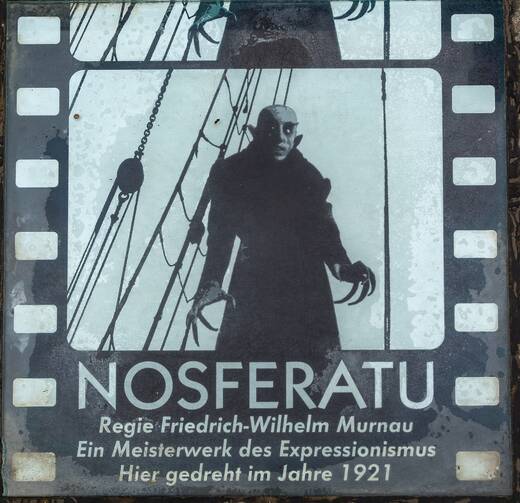“Nosferatu” (1922), directed by F. W. Murnau and written by Henrik Galeen, is a foundational classic of the horror genre. But it also holds the distinction of being the only horror film recommended by the Vatican.
In 1995, the Vatican published a list of 45 significant films from across the medium’s first century. The list, compiled by the Pontifical Council for Social Communications (which eventually became the modern Dicastery for Communications), was not a “best of,” but a guide to “some important films” in the categories of Religion, Values and Art. It is a diverse collection, including obviously religious films like “The Flowers of St. Francis” (1950) and “The Mission” (1986) alongside secular classics such as “2001: A Space Odyssey” (1968) and “Stagecoach” (1939).
“Nosferatu” was recognized in the Art category, and it certainly earns its place. In this silent film, Murnau crafts a powerful, eerie atmosphere with images alone: a huge, sinister building crouched on the waterfront, a parade of black coffins through a plague-stricken town. A masterpiece of the German Expressionist style, “Nosferatu” uses dramatic shadows and exaggerated performances to heighten its gothic mood. The vampire at its heart, Count Orlok (Max Schreck), is one of horror’s first iconic monsters: a maggot-pale fiend from the depths of hell with long, grasping fingers, sunken eyes and prominent fangs. While not jump-out-of-your-seat scary by modern standards, “Nosferatu” still unnerves after all of these years.
Beyond its artistic merits, you can see why the Vatican held “Nosferatu” up as a film that would speak to audiences across the ages. It is a potent portrait of evil, both supernatural and mundane. We see a German town suffering from a plague (really Orlok preying on its citizenry at night). Soon their fear and helplessness curdle into anger and they begin looking for a scapegoat. Mobs stalk the streets despite what we would now call “shelter in place” restrictions (the plague scenes take on an additional eerie resonance after the Covid-19 pandemic). At one point they accost a scarecrow by mistake. Even after realizing their error, members of the crowd continue to beat the straw figure, their rage accepting any outlet it can find. Orlok isn’t merely a predator: His presence brings out the worst in people. They can’t recognize the real evil because they are too busy turning against each other. In a chilling historical note, the film came out only about a decade before the Nazi party’s rise to power in Murnau’s native Germany.
The film counters this darkness with the virtue of heroic self-sacrifice. Partially following the plot of Dracula (the film is an unauthorized adaptation), “Nosferatu” centers on Hutter (Gustav von Wangenheim), an estate agent who goes to Transylvania to meet with a client, the mysterious Orlok. Hutter is an affable dope who unwittingly allows evil to find a foothold in his hometown. Waiting and worrying for him is his wife Ellen (Greta Schröder), who forms a dangerous psychic connection with Orlok. Ultimately, she realizes that the only way to stop the vampire is to sacrifice herself. Despite being portrayed as gentle and even a little frail earlier in the film, Ellen approaches her fate with courage and resolve, performed powerfully by Schröder. Surrounded by other characters who are, largely, either evil or clueless, Ellen embodies the best of humanity. Her sacrifice echoes Christ’s, driven by what the Gospels call the greatest love of all: to lay down one’s life to save others.
A century after its release, “Nosferatu” retains its haunting cinematic power (and continues to justify its place on the Vatican’s list). Perhaps we should be most troubled by how relevant it feels. Evil still casts its shadow over the world, people still respond with fear, blame and violence, and salvation is only possible through sacrifice.
“Nosferatu” is streaming on Tubi and the Roku Channel. A colorized version is streaming on Amazon Prime.








